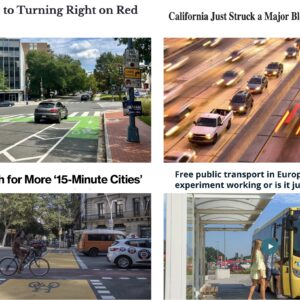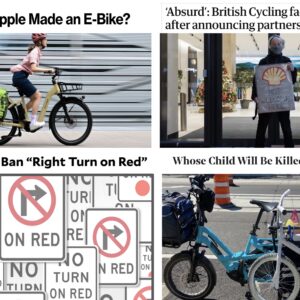In Seattle, bicycle politics are getting a little heated, though many aren’t sure why.
Here’s the bike and transportation news that caught my eye last week:
– Bike to Work Week led to a lot of positive press about bicycling last week. Here’s one woman’s story about overcoming her fear of bicycling. And there was plenty of excellent advice floating around the web for first-time bike commuters of all stripes, including drag queens.
– An inside look at how U.S. bike sharing systems are different than their European forebears and what cities will launch bike sharing in the next few years.
– In Seattle, bicycle politics are getting a little heated, though many aren’t sure why.
– In a bike-car crash, who’s at fault more often? This overview of a handful of studies is inconclusive.
– A big shot transportation planner explains why she thinks stop signs should be treated differently when you’re on a bicycle.
– Sharrows continue their unstoppable proliferation over the asphalt surfaces of the nation.
– A visitor to Portland considers how his own town of Santa Monica, California could become the next superstar bicycling city.
– In San Francisco, BART officials are reconsidering the current ban of bicycles from escalators.
– A look inside the growing cycle chic industrial complex.
– Bike shop/coffeeshop hybrids make a list of the top five hottest foodie trends.
– Ciclovia season is underway, bringing with it plenty of smiles and exuberant uses of the road.
– A unique twist on the drive-in allows you to bike right up to a restaurant’s outdoor seating and enjoy your meal without dismounting.
– Video(s) of the week: Streetfilms is doing a phenomenal job with their new series, My NYC Biking Story, featuring very short profiles of a diverse array of people talking about why and how they ride. Here’s the most recent one…
My NYC Biking Story: Lucette Gilbert from Streetfilms on Vimeo.






Thanks for reading.
BikePortland has served this community with independent community journalism since 2005. We rely on subscriptions from readers like you to survive. Your financial support is vital in keeping this valuable resource alive and well.
Please subscribe today to strengthen and expand our work.
another interesting story on the importance of bicycling
http://americancity.org/buzz/entry/2982/?sms_ss=linkedin&at_xt=4dda618c0a3501a5%2C0
“In much of inner Southeast and Northeast Portland, this evolution is already occurring, as motorists frequently gesture cyclists through stop signs even when the cyclist is obliged to stop. I experience this much-appreciated kindness every day, and always respond with a smile and wave.”
I don’t know. In the absence of an Idaho stop law and with the oft-heard attitude about ‘cyclists running stop signs’ being encouraged to ‘run a stop sign’ by someone in a car hasn’t struck me as helpful. Nice to know that Mia Birk thinks this a helpful gesture. I’d not thought of it as about internalized differences in momentum.
I agree, I don’t really like being waved through by drivers. I’d rather stop and wait, as expected, then have someone play “nice traffic cop” and wave me through, even if their intent is good. Sometimes other drivers get impatient and will (illegally, I might add) pass cars that are holding them up. I do like when drivers try to be nice… but one of my rules is to staying safe is to ride in a predictable manner.
On the whole Idaho stop law thing, I agree it’s a good idea – on a bike it’s so much easier to see if it’s safe to proceed or not. However, it’s going to be a hard law to get passed – in the article, there were lots of comments from drivers, which basically sound like bratty kids, i.e. “well if we can’t do it, they can’t either!!”.
This, of course, ignores the complete distinction between driving and cycling modes. Sure, they may be treated the same by the laws currently, because it was easier for law makers to just tack that on back in the day, but it’s going to have to change soon. Cars and bikes are very much different, and need different laws governing how their operators can act.
Actually your last paragraph is exactly backwards. Until the 1980’s bicycles WERE treated differently in the laws of many states, always to the detriment of cycling. It took a huge amount of work by bicycle advocates to get those laws changed to give bicyclists the same rights (and responsibilities) as motor vehicle drivers. So before you advocate going back to separate laws for cyclists I strongly recommend you read up on your history, lest you find yourself back in the “bad old days”.
“Separate but Equal” has always had implementation problems not to mention the social perceptual amplification of any differences.
It has proven to be a scheme capable of only ensuring the exact opposite of what its title calls for.
this kind of behavior is potentially dangerous. i’ve seen near-accidents on hawthorne and other two lane streets. often the “wave-alongers” are also holding up other traffic. i now always wait until they give up.
Here is a story I heard on the radio a while back.
Our radio host was cycling with a female friend when she stopped at a red light. Since she stopped, he stopped too. Then another cyclist passed them and rolled right through the intersection. She shouted to him, in what our host called her best mom voice, “You are why they hate us.”
Happens to me *daily* in Ladd’s. I always just politely say, “Stop sign.” No need to be a dick about it, but I have had people almost run me over in their rush to get into the Circle, and I am the “Bicycling Lumberjack.” — not a small guy on a small bike. I am out every day, rain or shine, riding to work and back.
hate? really?
motorists are *such* prima donnas.
the NPR story links to a page from bicycling mag
http://www.bicycling.com/training-nutrition/injury-prevention/overtaking
that lists the five top car/bike crash scenarios: left hook, right hook, dooring, car entering roadway from driveway or sidestreet, and overtaking. though most of these are avoidable by a vigilant cyclist, zero are the “fault” of a cyclist. so any stats that give anything close to fifty percent of fault to cyclists are by definition wrong.
Isn’t part of the Problem with Ladd’s that a round about is being utilized in an improper way?
A unique twist on the drive-in allows you to bike right up to a restaurant’s outdoor seating and enjoy your meal without dismounting.
Both my saddles are pretty comfy but even after only 15 or 20 minutes, I’d just as soon dismount for a coffee stop, let alone a meal. Even sitting in an Aeron gets old after an hour. No way can my seat post fit a Laz-y-boy recliner. Maybe recumbents could use a drive-in but that one obviously own’t work.
I was thinking the same thing. When I stop somewhere I’d just as soon get off my bike.
“- A big shot transportation planner explains why she thinks stop signs should be treated differently when you’re on a bicycle.” bikeportland ‘Monday Roundup’ elly blue
Who is this ‘big shot’ ? Read the article…it’s Mia Birk. That’s probably blue making an affectionate joke, but in a serious vein, I hope Birk has a more modest and realistic view of her status in transportation planning than blue does.
In the Portland Tribune article, Ms Birk, uses for an example of a situation she believes calls for allowing cyclists not to have to stop at stop signs…the quiet Ladd’s Addition neighborhood. Many years back, certain streets through Ladd’s as some people may be aware, were…before Portland’s big boom in commuter cycling… designated as bike routes, the city’s leadership probably not fully realizing the actual number of cyclists that would eventually come to use this neighborhood’s streets, particularly during commute hours.
Many of the cyclists choosing to ride through Ladd’s quiet streets, rather than the slightly longer, but busier, traffic light signaled routes on 20th or 12th to the west and east of Ladd’s, apparently feel unduly burdened by being obliged to stop at Ladd’s seven stop signs on the commute route.
As the numbers of these types of cyclists traveling through Ladd’s Addition goes up, the livability of Ladd’s Addition is negatively affected as a result of their rejection of many reasons for stopping at stop signs on the neighborhood’s streets.
So first of all, remove Ladd’s Addition as an example of a typical bike traffic situation, from any argument as to why bike traffic should be allowed a variance from laws pertaining to vehicle compliance with stop signs, because from the standpoint of good planning, quiet neighborhoods such as this one should probably not be designated as major bicycle commute routes.
To some of the rest of the points Birk attempts to raise in favor of allowing cyclists to exclusively roll through stop signs: A bike and rider may weigh less than a 2000lb+ motor vehicle, but a bike with rider crashing into a pedestrian can cause very serious injury to the person struck…possibly the cyclist as well. Even when pedestrians or other vehicles aren’t present, it isn’t a great idea to promote bad habits of not stopping at stop signs, that enter into play into situations where pedestrians and other vehicles are present. With the economy, gas and energy crisis growing, it’s not just more cyclists that are taking to the street…it’s people on foot that are too. My guess, is that with each cyclist ‘roll through’ they experience, they’re less impressed with the regard such cyclists seem to have for other road users.
Motor vehicle operators can’t be blamed for being less than enthusiastic about having to be extra vigilant for cyclists, should they be given exclusive right to roll stop signs. Sure…with existing laws that allow the roll through, technically, the responsibility lies with the cyclist for determining the way through the stop sign and onto the roadway is clear; good luck sorting that out in court though, where questions about the burden of responsibility for resulting collisions is likely to automatically turn to the operator of the heavier motor vehicle.
“Motor vehicle operators can’t be blamed for being less than enthusiastic about having to be extra vigilant for cyclists, should they be given exclusive right to roll stop signs.”
Oh, my.
These days, as we’ve had plenty of occasion to learn the tables are tilted the other way. Stings for running stop signs in Portland are/have been/probably will continue to be orchestrated specifically and disproportionately for bikes, and locations where bikes predominate, rather than for cars, say, which also roll through stop signs, as everyone seems to agree. There’s your exclusive right right now.
Enforcement details directed towards cyclists rolling stop signs get attention on bikeportland. That’s no clear indication of a specific or disproportionate amount of enforcement details directed towards cyclists rather than motor vehicle operators.
Do you happen to know of records of the range of stop sign enforcement details the PD has been conducting, showing that details have been specifically and disproportionately directed towards places where bikes predominate, rather than where the traffic might be less predominately bike?
If I remember correctly from past bikeportland stories about stop sign enforcement details in the Ladd’s Addition neighborhoods, motor vehicles rolling through stop signs in that neighborhood reportedly got tickets too, along with cyclists that rolled the stop signs.